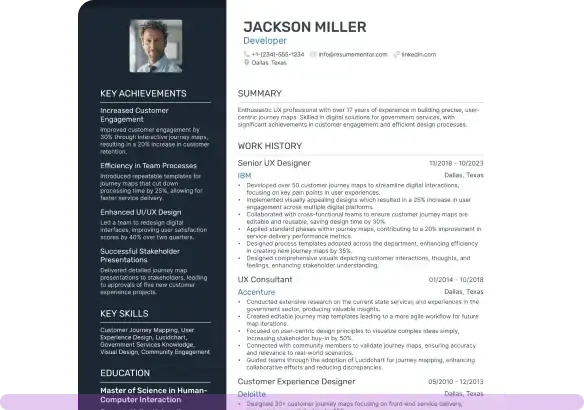Firefighter Resume Examples

Mar 26, 2025
|
12 min read
Ignite your career with a firefighter resume that truly stands out. Learn to showcase your skills, bravery, and dedication. Tailor your application to spark interest and land interviews faster than a fire engine on a freeway.
Rated by 348 people
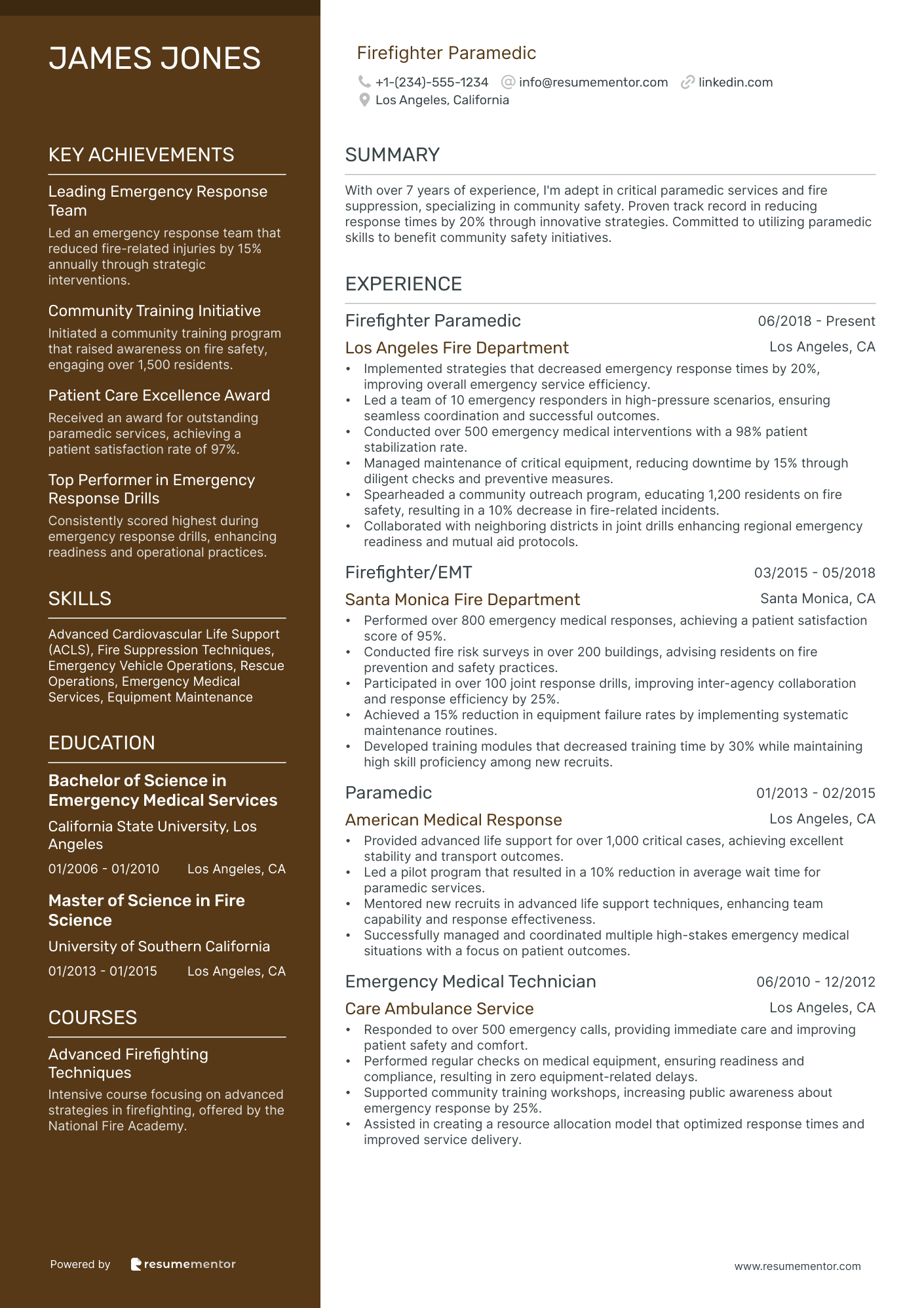
Firefighter Paramedic
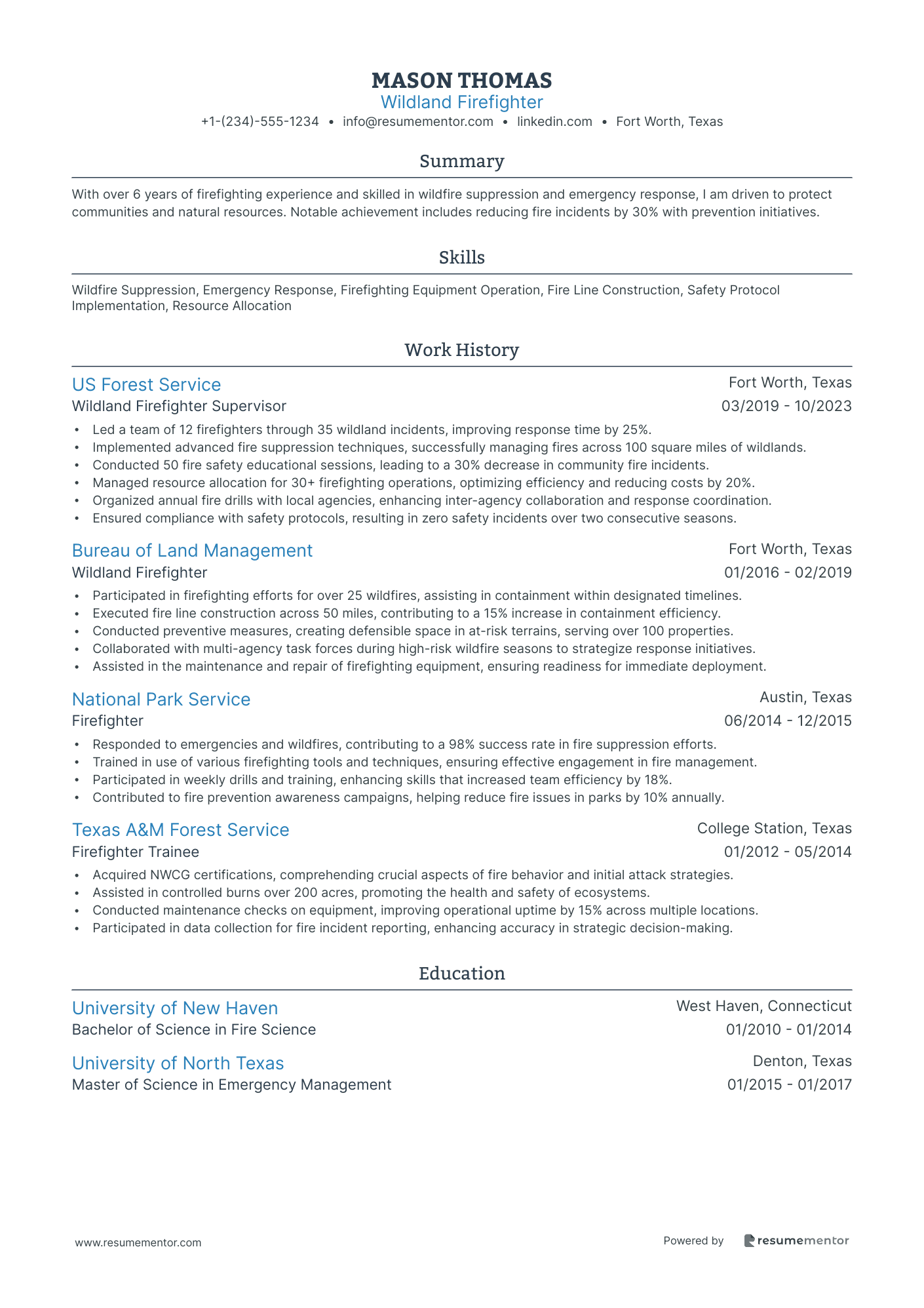
Wildland Firefighter
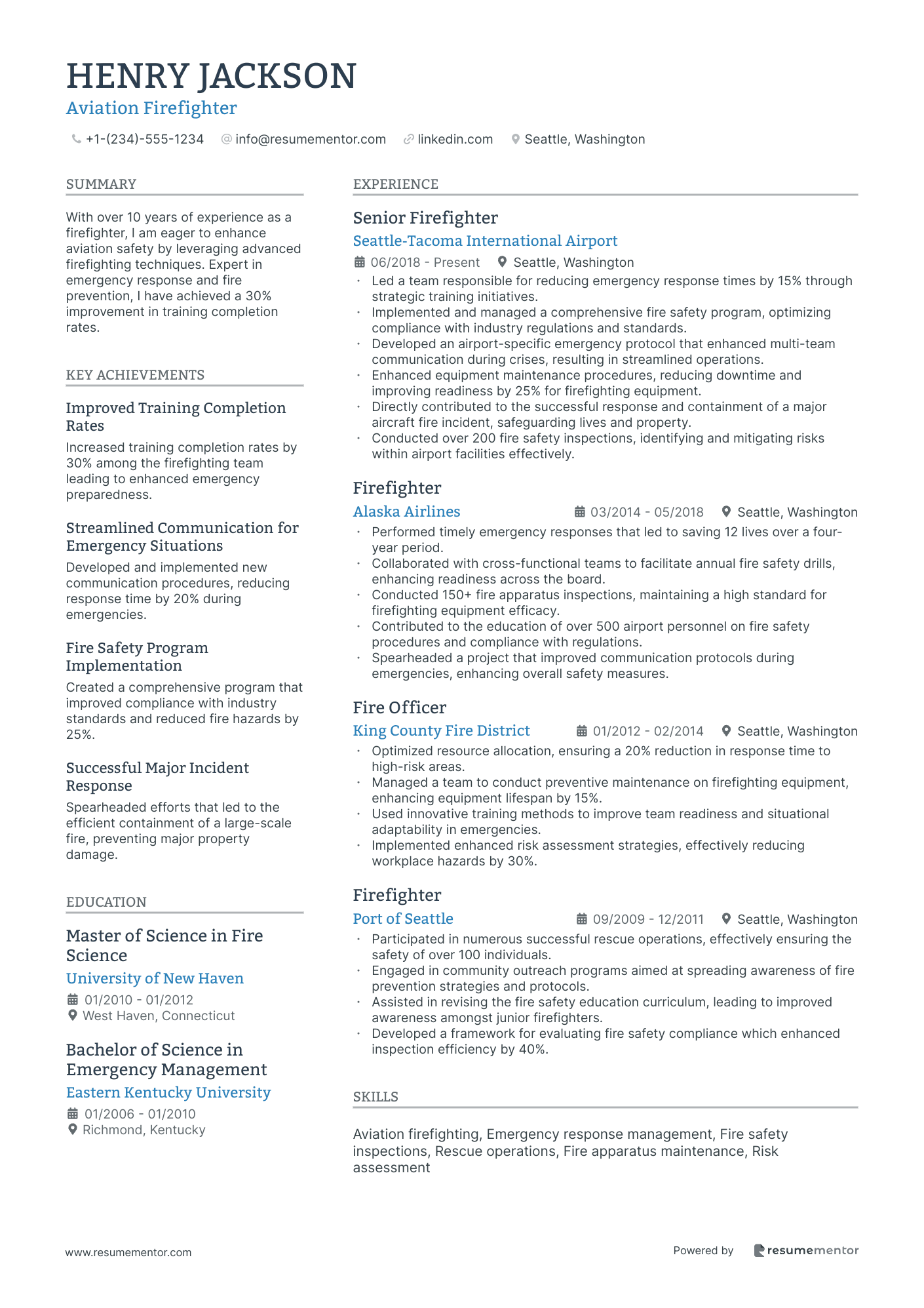
Aviation Firefighter
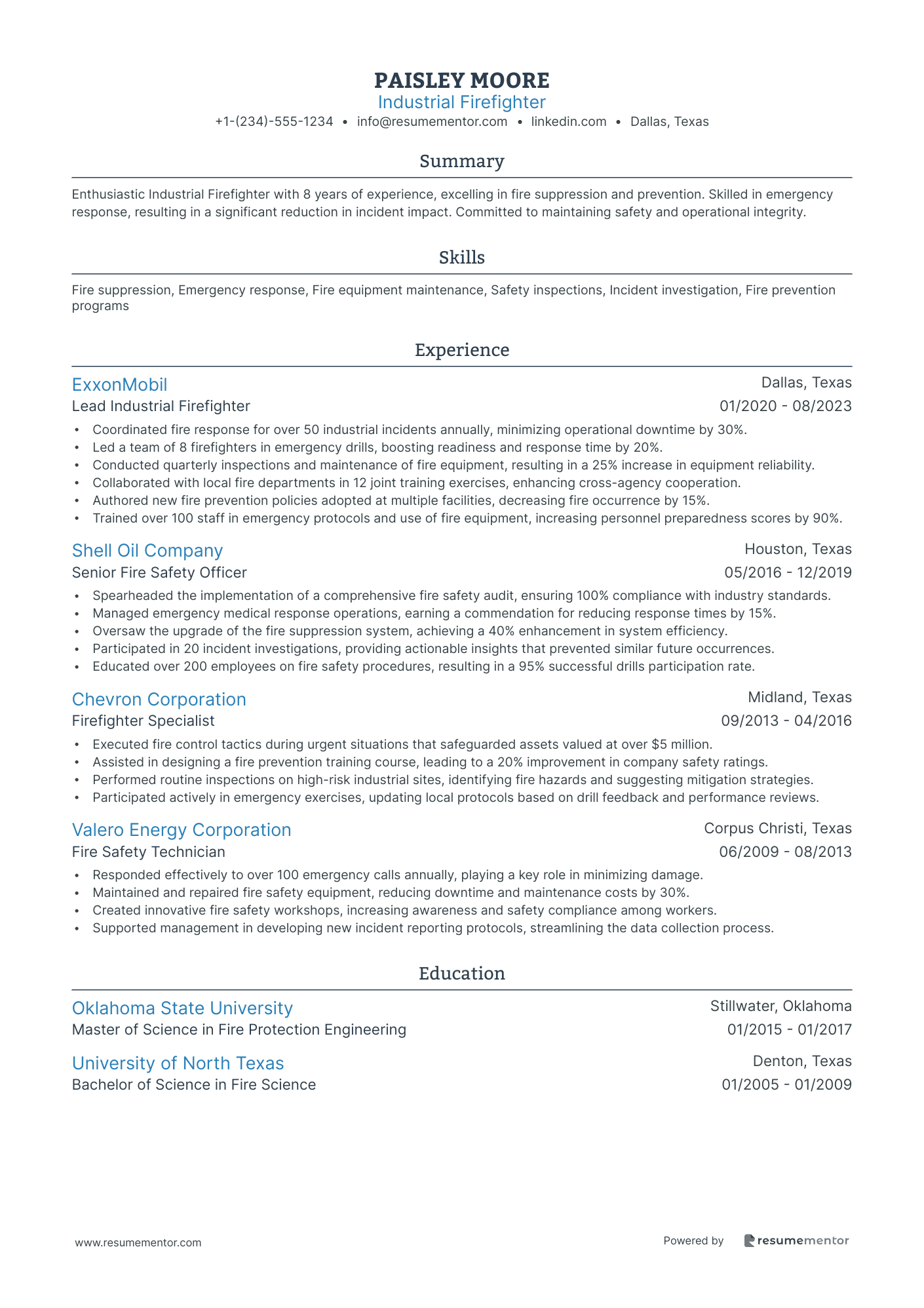
Industrial Firefighter
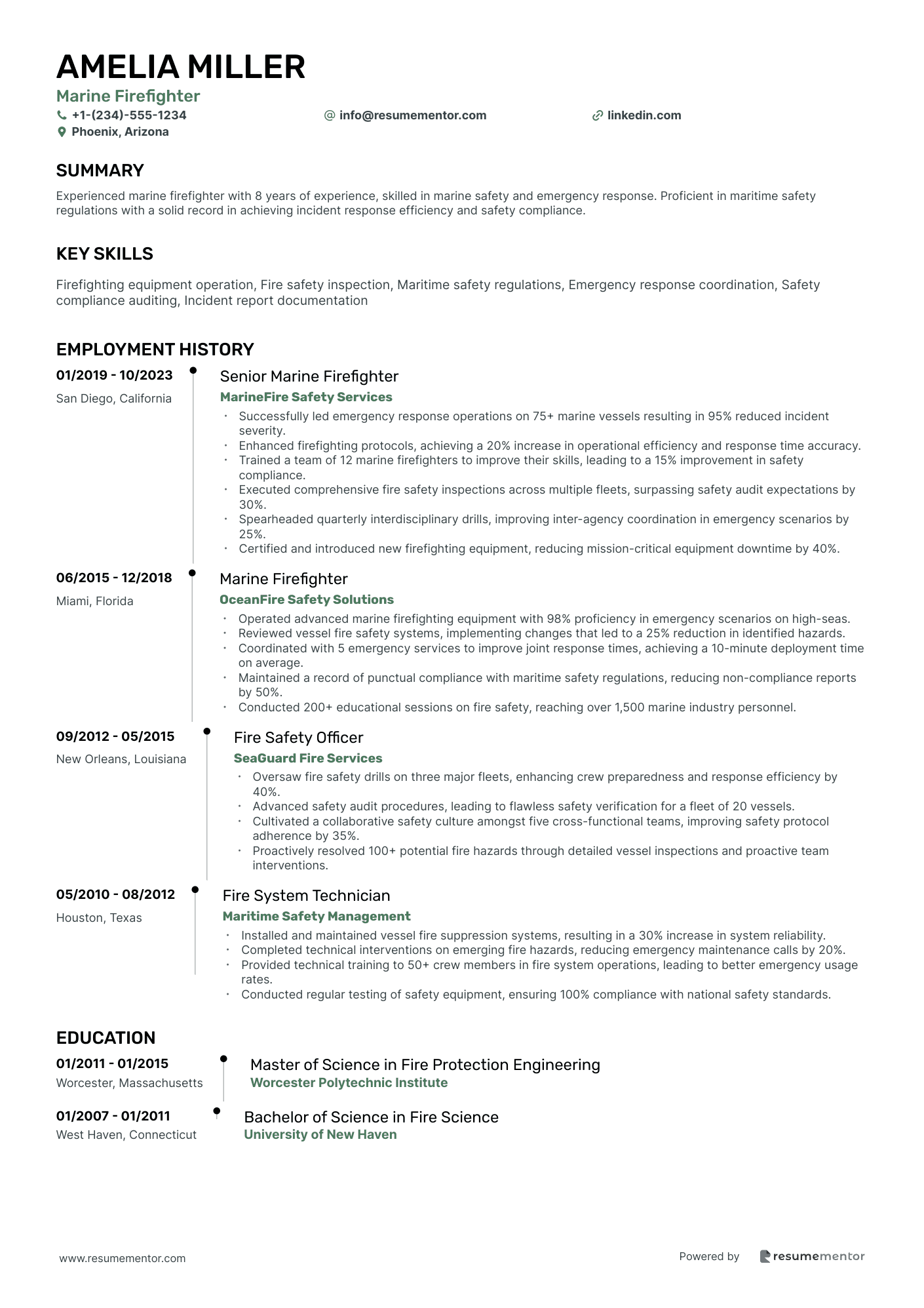
Marine Firefighter
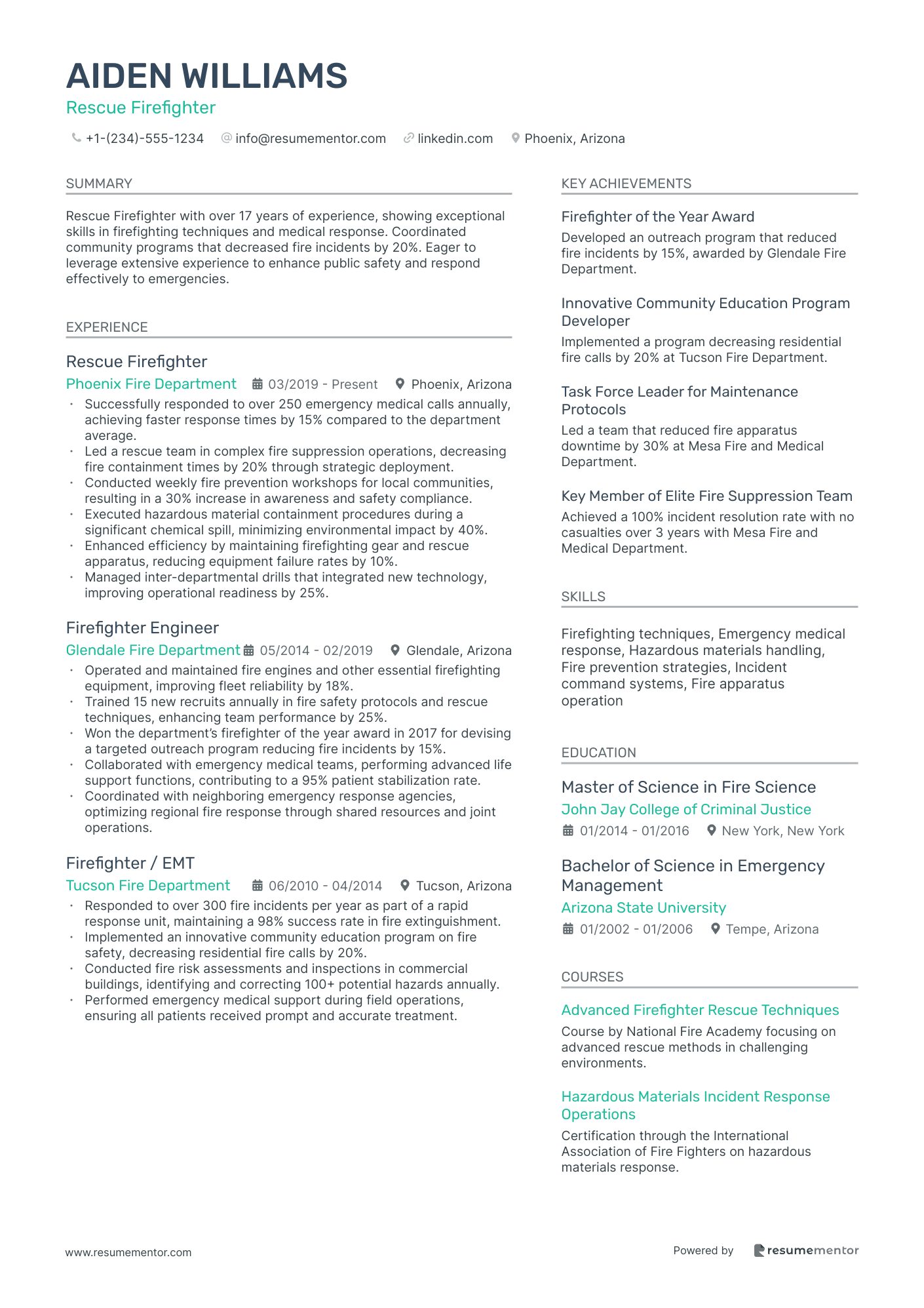
Rescue Firefighter
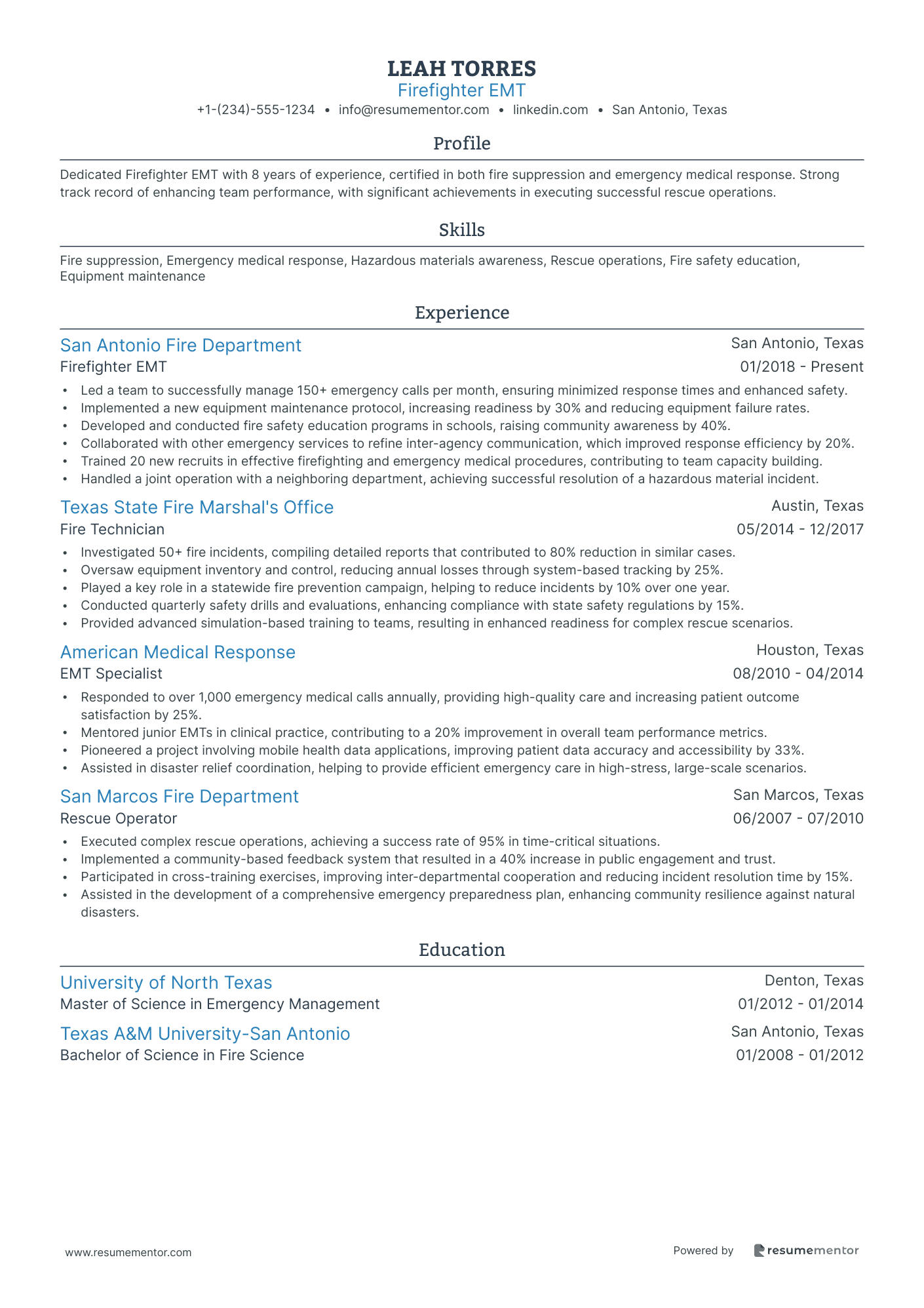
Firefighter EMT
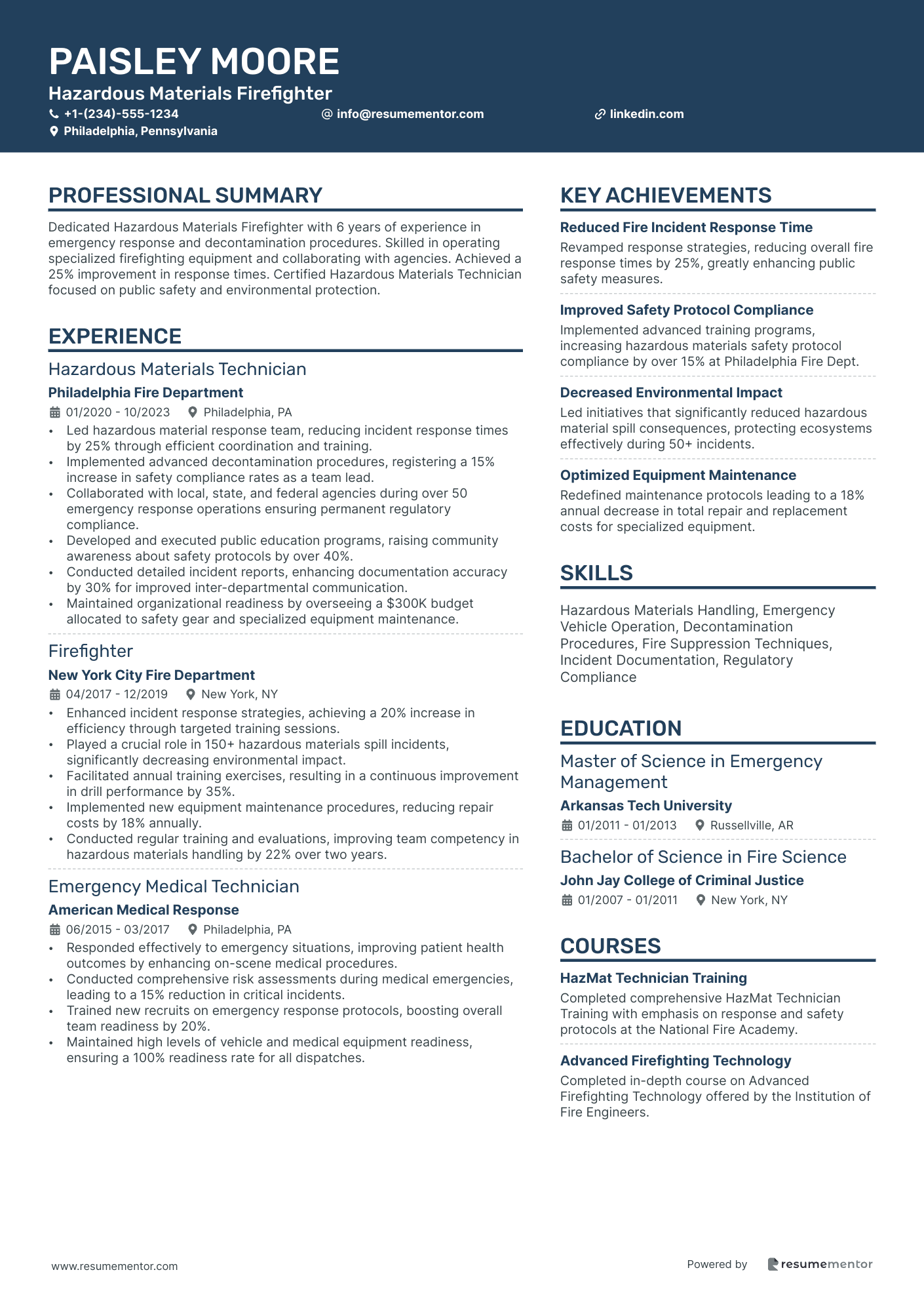
Hazardous Materials Firefighter
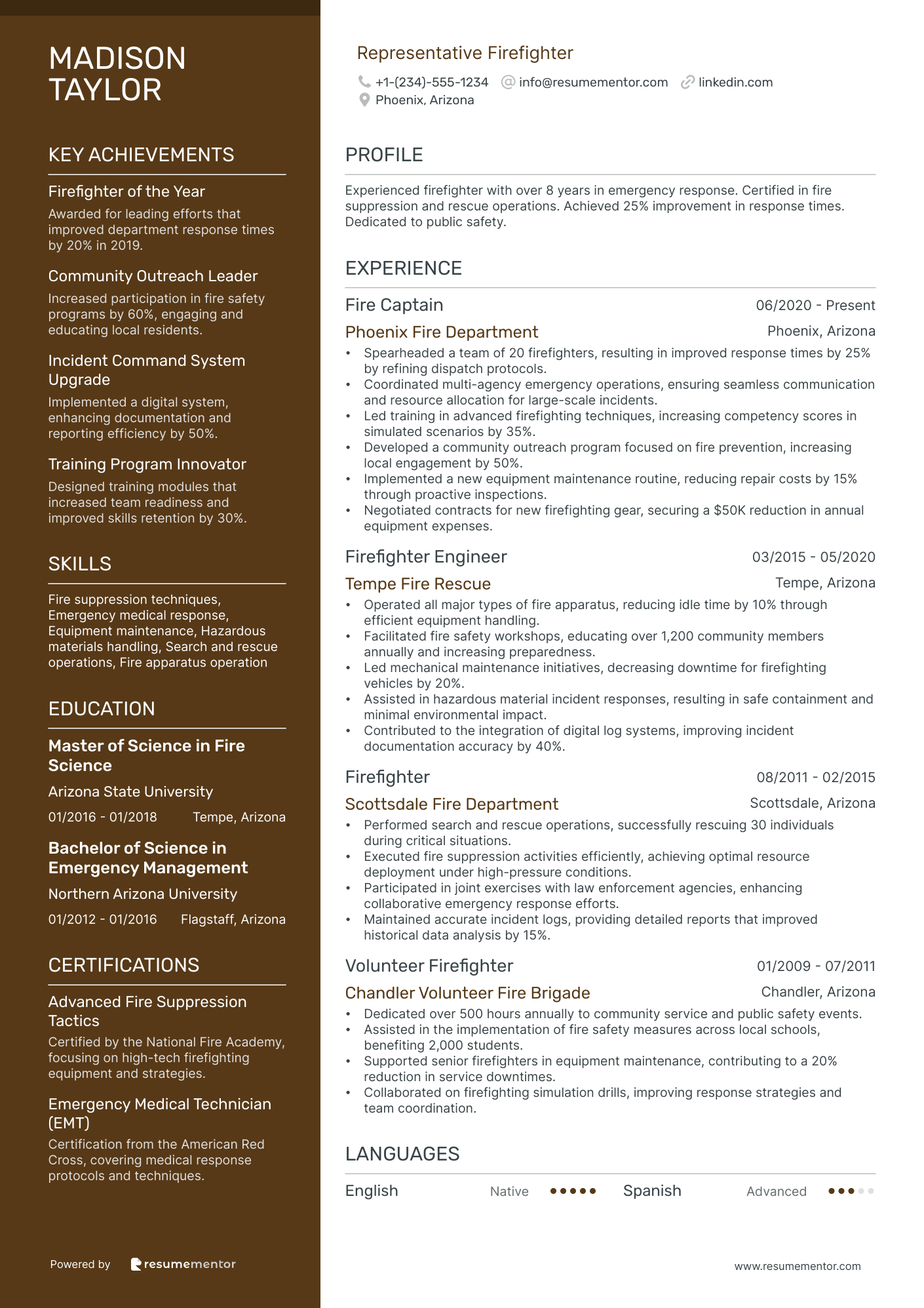
Representative Firefighter
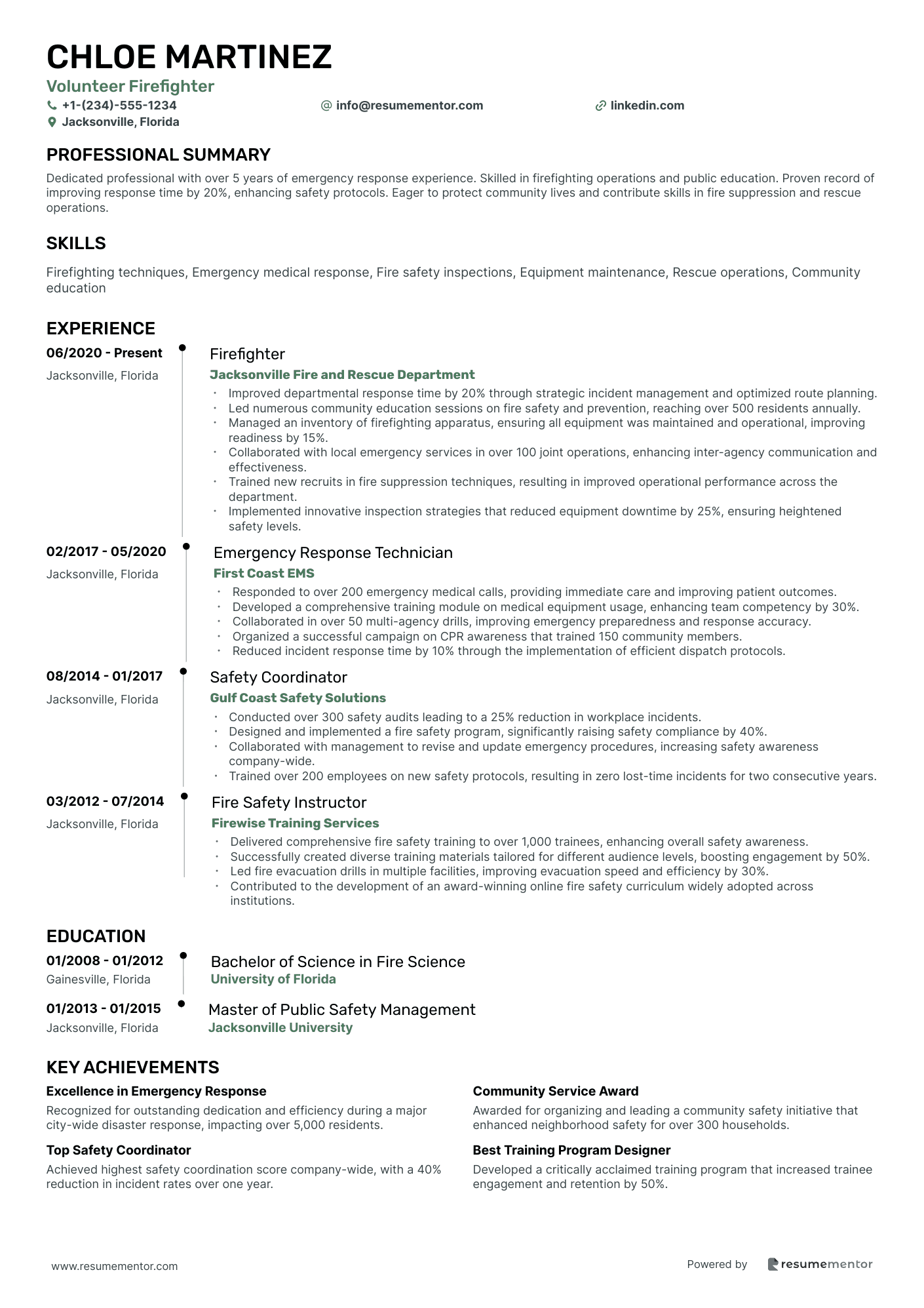
Volunteer Firefighter

Firefighter Paramedic resume sample
- •Implemented strategies that decreased emergency response times by 20%, improving overall emergency service efficiency.
- •Led a team of 10 emergency responders in high-pressure scenarios, ensuring seamless coordination and successful outcomes.
- •Conducted over 500 emergency medical interventions with a 98% patient stabilization rate.
- •Managed maintenance of critical equipment, reducing downtime by 15% through diligent checks and preventive measures.
- •Spearheaded a community outreach program, educating 1,200 residents on fire safety, resulting in a 10% decrease in fire-related incidents.
- •Collaborated with neighboring districts in joint drills enhancing regional emergency readiness and mutual aid protocols.
- •Performed over 800 emergency medical responses, achieving a patient satisfaction score of 95%.
- •Conducted fire risk surveys in over 200 buildings, advising residents on fire prevention and safety practices.
- •Participated in over 100 joint response drills, improving inter-agency collaboration and response efficiency by 25%.
- •Achieved a 15% reduction in equipment failure rates by implementing systematic maintenance routines.
- •Developed training modules that decreased training time by 30% while maintaining high skill proficiency among new recruits.
- •Provided advanced life support for over 1,000 critical cases, achieving excellent stability and transport outcomes.
- •Led a pilot program that resulted in a 10% reduction in average wait time for paramedic services.
- •Mentored new recruits in advanced life support techniques, enhancing team capability and response effectiveness.
- •Successfully managed and coordinated multiple high-stakes emergency medical situations with a focus on patient outcomes.
- •Responded to over 500 emergency calls, providing immediate care and improving patient safety and comfort.
- •Performed regular checks on medical equipment, ensuring readiness and compliance, resulting in zero equipment-related delays.
- •Supported community training workshops, increasing public awareness about emergency response by 25%.
- •Assisted in creating a resource allocation model that optimized response times and improved service delivery.
Wildland Firefighter resume sample
- •Led a team of 12 firefighters through 35 wildland incidents, improving response time by 25%.
- •Implemented advanced fire suppression techniques, successfully managing fires across 100 square miles of wildlands.
- •Conducted 50 fire safety educational sessions, leading to a 30% decrease in community fire incidents.
- •Managed resource allocation for 30+ firefighting operations, optimizing efficiency and reducing costs by 20%.
- •Organized annual fire drills with local agencies, enhancing inter-agency collaboration and response coordination.
- •Ensured compliance with safety protocols, resulting in zero safety incidents over two consecutive seasons.
- •Participated in firefighting efforts for over 25 wildfires, assisting in containment within designated timelines.
- •Executed fire line construction across 50 miles, contributing to a 15% increase in containment efficiency.
- •Conducted preventive measures, creating defensible space in at-risk terrains, serving over 100 properties.
- •Collaborated with multi-agency task forces during high-risk wildfire seasons to strategize response initiatives.
- •Assisted in the maintenance and repair of firefighting equipment, ensuring readiness for immediate deployment.
- •Responded to emergencies and wildfires, contributing to a 98% success rate in fire suppression efforts.
- •Trained in use of various firefighting tools and techniques, ensuring effective engagement in fire management.
- •Participated in weekly drills and training, enhancing skills that increased team efficiency by 18%.
- •Contributed to fire prevention awareness campaigns, helping reduce fire issues in parks by 10% annually.
- •Acquired NWCG certifications, comprehending crucial aspects of fire behavior and initial attack strategies.
- •Assisted in controlled burns over 200 acres, promoting the health and safety of ecosystems.
- •Conducted maintenance checks on equipment, improving operational uptime by 15% across multiple locations.
- •Participated in data collection for fire incident reporting, enhancing accuracy in strategic decision-making.
Aviation Firefighter resume sample
- •Led a team responsible for reducing emergency response times by 15% through strategic training initiatives.
- •Implemented and managed a comprehensive fire safety program, optimizing compliance with industry regulations and standards.
- •Developed an airport-specific emergency protocol that enhanced multi-team communication during crises, resulting in streamlined operations.
- •Enhanced equipment maintenance procedures, reducing downtime and improving readiness by 25% for firefighting equipment.
- •Directly contributed to the successful response and containment of a major aircraft fire incident, safeguarding lives and property.
- •Conducted over 200 fire safety inspections, identifying and mitigating risks within airport facilities effectively.
- •Performed timely emergency responses that led to saving 12 lives over a four-year period.
- •Collaborated with cross-functional teams to facilitate annual fire safety drills, enhancing readiness across the board.
- •Conducted 150+ fire apparatus inspections, maintaining a high standard for firefighting equipment efficacy.
- •Contributed to the education of over 500 airport personnel on fire safety procedures and compliance with regulations.
- •Spearheaded a project that improved communication protocols during emergencies, enhancing overall safety measures.
- •Optimized resource allocation, ensuring a 20% reduction in response time to high-risk areas.
- •Managed a team to conduct preventive maintenance on firefighting equipment, enhancing equipment lifespan by 15%.
- •Used innovative training methods to improve team readiness and situational adaptability in emergencies.
- •Implemented enhanced risk assessment strategies, effectively reducing workplace hazards by 30%.
- •Participated in numerous successful rescue operations, effectively ensuring the safety of over 100 individuals.
- •Engaged in community outreach programs aimed at spreading awareness of fire prevention strategies and protocols.
- •Assisted in revising the fire safety education curriculum, leading to improved awareness amongst junior firefighters.
- •Developed a framework for evaluating fire safety compliance which enhanced inspection efficiency by 40%.
Industrial Firefighter resume sample
- •Coordinated fire response for over 50 industrial incidents annually, minimizing operational downtime by 30%.
- •Led a team of 8 firefighters in emergency drills, boosting readiness and response time by 20%.
- •Conducted quarterly inspections and maintenance of fire equipment, resulting in a 25% increase in equipment reliability.
- •Collaborated with local fire departments in 12 joint training exercises, enhancing cross-agency cooperation.
- •Authored new fire prevention policies adopted at multiple facilities, decreasing fire occurrence by 15%.
- •Trained over 100 staff in emergency protocols and use of fire equipment, increasing personnel preparedness scores by 90%.
- •Spearheaded the implementation of a comprehensive fire safety audit, ensuring 100% compliance with industry standards.
- •Managed emergency medical response operations, earning a commendation for reducing response times by 15%.
- •Oversaw the upgrade of the fire suppression system, achieving a 40% enhancement in system efficiency.
- •Participated in 20 incident investigations, providing actionable insights that prevented similar future occurrences.
- •Educated over 200 employees on fire safety procedures, resulting in a 95% successful drills participation rate.
- •Executed fire control tactics during urgent situations that safeguarded assets valued at over $5 million.
- •Assisted in designing a fire prevention training course, leading to a 20% improvement in company safety ratings.
- •Performed routine inspections on high-risk industrial sites, identifying fire hazards and suggesting mitigation strategies.
- •Participated actively in emergency exercises, updating local protocols based on drill feedback and performance reviews.
- •Responded effectively to over 100 emergency calls annually, playing a key role in minimizing damage.
- •Maintained and repaired fire safety equipment, reducing downtime and maintenance costs by 30%.
- •Created innovative fire safety workshops, increasing awareness and safety compliance among workers.
- •Supported management in developing new incident reporting protocols, streamlining the data collection process.
Marine Firefighter resume sample
- •Successfully led emergency response operations on 75+ marine vessels resulting in 95% reduced incident severity.
- •Enhanced firefighting protocols, achieving a 20% increase in operational efficiency and response time accuracy.
- •Trained a team of 12 marine firefighters to improve their skills, leading to a 15% improvement in safety compliance.
- •Executed comprehensive fire safety inspections across multiple fleets, surpassing safety audit expectations by 30%.
- •Spearheaded quarterly interdisciplinary drills, improving inter-agency coordination in emergency scenarios by 25%.
- •Certified and introduced new firefighting equipment, reducing mission-critical equipment downtime by 40%.
- •Operated advanced marine firefighting equipment with 98% proficiency in emergency scenarios on high-seas.
- •Reviewed vessel fire safety systems, implementing changes that led to a 25% reduction in identified hazards.
- •Coordinated with 5 emergency services to improve joint response times, achieving a 10-minute deployment time on average.
- •Maintained a record of punctual compliance with maritime safety regulations, reducing non-compliance reports by 50%.
- •Conducted 200+ educational sessions on fire safety, reaching over 1,500 marine industry personnel.
- •Oversaw fire safety drills on three major fleets, enhancing crew preparedness and response efficiency by 40%.
- •Advanced safety audit procedures, leading to flawless safety verification for a fleet of 20 vessels.
- •Cultivated a collaborative safety culture amongst five cross-functional teams, improving safety protocol adherence by 35%.
- •Proactively resolved 100+ potential fire hazards through detailed vessel inspections and proactive team interventions.
- •Installed and maintained vessel fire suppression systems, resulting in a 30% increase in system reliability.
- •Completed technical interventions on emerging fire hazards, reducing emergency maintenance calls by 20%.
- •Provided technical training to 50+ crew members in fire system operations, leading to better emergency usage rates.
- •Conducted regular testing of safety equipment, ensuring 100% compliance with national safety standards.
Rescue Firefighter resume sample
- •Successfully responded to over 250 emergency medical calls annually, achieving faster response times by 15% compared to the department average.
- •Led a rescue team in complex fire suppression operations, decreasing fire containment times by 20% through strategic deployment.
- •Conducted weekly fire prevention workshops for local communities, resulting in a 30% increase in awareness and safety compliance.
- •Executed hazardous material containment procedures during a significant chemical spill, minimizing environmental impact by 40%.
- •Enhanced efficiency by maintaining firefighting gear and rescue apparatus, reducing equipment failure rates by 10%.
- •Managed inter-departmental drills that integrated new technology, improving operational readiness by 25%.
- •Operated and maintained fire engines and other essential firefighting equipment, improving fleet reliability by 18%.
- •Trained 15 new recruits annually in fire safety protocols and rescue techniques, enhancing team performance by 25%.
- •Won the department’s firefighter of the year award in 2017 for devising a targeted outreach program reducing fire incidents by 15%.
- •Collaborated with emergency medical teams, performing advanced life support functions, contributing to a 95% patient stabilization rate.
- •Coordinated with neighboring emergency response agencies, optimizing regional fire response through shared resources and joint operations.
- •Responded to over 300 fire incidents per year as part of a rapid response unit, maintaining a 98% success rate in fire extinguishment.
- •Implemented an innovative community education program on fire safety, decreasing residential fire calls by 20%.
- •Conducted fire risk assessments and inspections in commercial buildings, identifying and correcting 100+ potential hazards annually.
- •Performed emergency medical support during field operations, ensuring all patients received prompt and accurate treatment.
- •Key member of an elite fire suppression team, achieving a 100% incident resolution rate with no casualties over 3 years.
- •Spearheaded a task force that improved fire apparatus maintenance protocols, reducing downtime by 30%.
- •Collaborated with local schools for fire safety education sessions, which saw over 5,000 student participants annually.
- •Assisted in the evaluation and adaptation of new firefighting technologies, enhancing operational efficiency by 10%.
Firefighter EMT resume sample
- •Led a team to successfully manage 150+ emergency calls per month, ensuring minimized response times and enhanced safety.
- •Implemented a new equipment maintenance protocol, increasing readiness by 30% and reducing equipment failure rates.
- •Developed and conducted fire safety education programs in schools, raising community awareness by 40%.
- •Collaborated with other emergency services to refine inter-agency communication, which improved response efficiency by 20%.
- •Trained 20 new recruits in effective firefighting and emergency medical procedures, contributing to team capacity building.
- •Handled a joint operation with a neighboring department, achieving successful resolution of a hazardous material incident.
- •Investigated 50+ fire incidents, compiling detailed reports that contributed to 80% reduction in similar cases.
- •Oversaw equipment inventory and control, reducing annual losses through system-based tracking by 25%.
- •Played a key role in a statewide fire prevention campaign, helping to reduce incidents by 10% over one year.
- •Conducted quarterly safety drills and evaluations, enhancing compliance with state safety regulations by 15%.
- •Provided advanced simulation-based training to teams, resulting in enhanced readiness for complex rescue scenarios.
- •Responded to over 1,000 emergency medical calls annually, providing high-quality care and increasing patient outcome satisfaction by 25%.
- •Mentored junior EMTs in clinical practice, contributing to a 20% improvement in overall team performance metrics.
- •Pioneered a project involving mobile health data applications, improving patient data accuracy and accessibility by 33%.
- •Assisted in disaster relief coordination, helping to provide efficient emergency care in high-stress, large-scale scenarios.
- •Executed complex rescue operations, achieving a success rate of 95% in time-critical situations.
- •Implemented a community-based feedback system that resulted in a 40% increase in public engagement and trust.
- •Participated in cross-training exercises, improving inter-departmental cooperation and reducing incident resolution time by 15%.
- •Assisted in the development of a comprehensive emergency preparedness plan, enhancing community resilience against natural disasters.
Hazardous Materials Firefighter resume sample
- •Led hazardous material response team, reducing incident response times by 25% through efficient coordination and training.
- •Implemented advanced decontamination procedures, registering a 15% increase in safety compliance rates as a team lead.
- •Collaborated with local, state, and federal agencies during over 50 emergency response operations ensuring permanent regulatory compliance.
- •Developed and executed public education programs, raising community awareness about safety protocols by over 40%.
- •Conducted detailed incident reports, enhancing documentation accuracy by 30% for improved inter-departmental communication.
- •Maintained organizational readiness by overseeing a $300K budget allocated to safety gear and specialized equipment maintenance.
- •Enhanced incident response strategies, achieving a 20% increase in efficiency through targeted training sessions.
- •Played a crucial role in 150+ hazardous materials spill incidents, significantly decreasing environmental impact.
- •Facilitated annual training exercises, resulting in a continuous improvement in drill performance by 35%.
- •Implemented new equipment maintenance procedures, reducing repair costs by 18% annually.
- •Conducted regular training and evaluations, improving team competency in hazardous materials handling by 22% over two years.
- •Responded effectively to emergency situations, improving patient health outcomes by enhancing on-scene medical procedures.
- •Conducted comprehensive risk assessments during medical emergencies, leading to a 15% reduction in critical incidents.
- •Trained new recruits on emergency response protocols, boosting overall team readiness by 20%.
- •Maintained high levels of vehicle and medical equipment readiness, ensuring a 100% readiness rate for all dispatches.
- •Successfully contained and controlled 180+ fire incidents ensuring minimized damages and maximal safety.
- •Conducted safety audits for hazardous materials storage facilities, enhancing policy compliance by 12%.
- •Implemented quality assurance checks, leading to a 20% decrease in equipment failure rates during emergencies.
- •Collaborated on cross-department projects to establish 16 new safety protocols.
Representative Firefighter resume sample
- •Spearheaded a team of 20 firefighters, resulting in improved response times by 25% by refining dispatch protocols.
- •Coordinated multi-agency emergency operations, ensuring seamless communication and resource allocation for large-scale incidents.
- •Led training in advanced firefighting techniques, increasing competency scores in simulated scenarios by 35%.
- •Developed a community outreach program focused on fire prevention, increasing local engagement by 50%.
- •Implemented a new equipment maintenance routine, reducing repair costs by 15% through proactive inspections.
- •Negotiated contracts for new firefighting gear, securing a $50K reduction in annual equipment expenses.
- •Operated all major types of fire apparatus, reducing idle time by 10% through efficient equipment handling.
- •Facilitated fire safety workshops, educating over 1,200 community members annually and increasing preparedness.
- •Led mechanical maintenance initiatives, decreasing downtime for firefighting vehicles by 20%.
- •Assisted in hazardous material incident responses, resulting in safe containment and minimal environmental impact.
- •Contributed to the integration of digital log systems, improving incident documentation accuracy by 40%.
- •Performed search and rescue operations, successfully rescuing 30 individuals during critical situations.
- •Executed fire suppression activities efficiently, achieving optimal resource deployment under high-pressure conditions.
- •Participated in joint exercises with law enforcement agencies, enhancing collaborative emergency response efforts.
- •Maintained accurate incident logs, providing detailed reports that improved historical data analysis by 15%.
- •Dedicated over 500 hours annually to community service and public safety events.
- •Assisted in the implementation of fire safety measures across local schools, benefiting 2,000 students.
- •Supported senior firefighters in equipment maintenance, contributing to a 20% reduction in service downtimes.
- •Collaborated on firefighting simulation drills, improving response strategies and team coordination.
Volunteer Firefighter resume sample
- •Improved departmental response time by 20% through strategic incident management and optimized route planning.
- •Led numerous community education sessions on fire safety and prevention, reaching over 500 residents annually.
- •Managed an inventory of firefighting apparatus, ensuring all equipment was maintained and operational, improving readiness by 15%.
- •Collaborated with local emergency services in over 100 joint operations, enhancing inter-agency communication and effectiveness.
- •Trained new recruits in fire suppression techniques, resulting in improved operational performance across the department.
- •Implemented innovative inspection strategies that reduced equipment downtime by 25%, ensuring heightened safety levels.
- •Responded to over 200 emergency medical calls, providing immediate care and improving patient outcomes.
- •Developed a comprehensive training module on medical equipment usage, enhancing team competency by 30%.
- •Collaborated in over 50 multi-agency drills, improving emergency preparedness and response accuracy.
- •Organized a successful campaign on CPR awareness that trained 150 community members.
- •Reduced incident response time by 10% through the implementation of efficient dispatch protocols.
- •Conducted over 300 safety audits leading to a 25% reduction in workplace incidents.
- •Designed and implemented a fire safety program, significantly raising safety compliance by 40%.
- •Collaborated with management to revise and update emergency procedures, increasing safety awareness company-wide.
- •Trained over 200 employees on new safety protocols, resulting in zero lost-time incidents for two consecutive years.
- •Delivered comprehensive fire safety training to over 1,000 trainees, enhancing overall safety awareness.
- •Successfully created diverse training materials tailored for different audience levels, boosting engagement by 50%.
- •Led fire evacuation drills in multiple facilities, improving evacuation speed and efficiency by 30%.
- •Contributed to the development of an award-winning online fire safety curriculum widely adopted across institutions.
Crafting a top-notch firefighter resume is not just another task—it's like preparing for a vital rescue mission. Emergencies rely on your skill and courage, and your resume should reflect that same expertise. This challenge often begins with turning real-world experience into impactful words on paper.
Effectively expressing your accomplishments and strengths is crucial. You might find yourself lost in technical jargon or possibly missing out on the soft skills that make you shine. Your ability to lead in high-pressure situations and work as part of a team are critical points to emphasize.
To streamline this process, a resume template can serve as a helpful guide. It allows you to organize your thoughts and present your experience in a clear manner. With structured layouts from resume templates, your resume will stand out effortlessly.
This guide will walk you through creating a resume that leaves a lasting impression. You'll discover how to highlight the most important information and tailor it to the job you’re targeting. Ready to turn your experiences into a compelling resume? Let’s dive in and give your career the boost it deserves.
Key Takeaways
- Crafting a firefighter resume requires turning real-world experiences into impactful and structured text to effectively convey skills and achievements, emphasizing teamwork and leadership under pressure.
- Utilizing a combination of chronological formatting and modern fonts supports clarity and professionalism, aiding recruiters in quickly grasping a candidate's progression and capabilities.
- A well-articulated experience section uses quantifiable achievements to demonstrate value and reliability, employing action verbs to vividly illustrate contributions and align with job requirements.
- Highlight both hard and soft skills separately, ensuring alignment with job descriptions to attract recruiter attention, and include additional sections for certifications and relevant skills.
- Complement the main sections with extra elements like language skills, hobbies, volunteer work, and relevant books read to provide a fuller picture of the candidate's suitability and passion for the role.
What to focus on when writing your firefighter resume
A firefighter resume should convey your dedication to safety, your emergency response capabilities, and your teamwork skills seamlessly. Through your experience and training, show recruiters that you are a capable and reliable candidate.
How to structure your firefighter resume
- Contact Information: Start strong with your full name, phone number, email, and address, ensuring all details are current so recruiters can easily reach you. An updated LinkedIn profile link can also provide additional insights into your professional journey.
- Professional Summary: Transition smoothly by offering a concise snapshot of your firefighting journey and commitment to public safety. Use this section to emphasize your most valuable skills and experiences, such as managing critical emergencies and operating essential firefighting equipment, to instantly grab the recruiter's attention.
- Work Experience: Naturally lead into listing your previous firefighting roles, where you should emphasize not only your responsibilities but also the key achievements that demonstrate your expertise. By detailing your life-saving actions and effective teamwork during emergencies, you paint a picture of your dedication and reliability in high-pressure situations.
- Education and Certifications: Build on this by detailing your relevant education and certifications, like Firefighter I and II, CPR, or EMT training. Include any specialized courses that show your ongoing commitment to learning and staying updated in the field, which underscores your technical expertise and readiness.
- Skills: Connect to specific skills such as emergency response, physical fitness, and proficiency with firefighting tools. Mentioning specialized training, like hazardous materials handling, can further set you apart by showing your readiness for diverse challenges.
- Volunteer Experience: Flow into any volunteer work related to firefighting or community safety, reflecting your dedication to serving the community beyond paid roles. This section can provide insight into your character and community-focused mindset, which are valuable assets in public safety roles.
To round out your resume, consider optional sections like "Awards and Honors" or "Professional Affiliations" to highlight additional achievements and memberships, further enhancing your profile and preparing you to dive deeper into the specifics of each section in resume format.
Which resume format to choose
Creating a standout firefighter resume begins with selecting the right format. A chronological resume is a smart choice for this field because it highlights your progressive experience and advancements. This format allows hiring managers to quickly grasp your journey and see how your skills have developed over time, making your dedication to firefighting evident.
Choosing the right font adds to this professionalism and clarity. Modern fonts such as Raleway, Lato, or Montserrat enhance readability and ensure your resume looks polished and contemporary. A clean, professional font underscores your attention to detail, an essential quality in the firefighting role.
Ensuring your resume reaches recruiters as intended involves using the correct file type. PDFs are ideal because they preserve your resume's format, regardless of which device or software the recruiter uses. This consistency reflects your organizational skills and ensures nothing is lost in translation.
Margins play a subtle yet essential role in your resume’s appearance. By keeping margins between 0.5 to 1 inch, you create a balanced layout that provides necessary white space, making it easier for recruiters to read your information quickly. A tidy, well-structured resume mirrors the discipline and order associated with being a firefighter.
By understanding these elements, you can craft a firefighter resume that highlights your skills and experience in the best light, making it professional and appealing to potential employers.
How to write a quantifiable resume experience section
Your firefighter resume's experience section is crucial for making a lasting impression, showing how you’re the right fit for the job. To make it stand out, focus on quantifiable achievements that highlight your skills. Organizing your experience in reverse chronological order brings the most relevant roles to the forefront, helping employers quickly understand your career progression. Include experiences from the last 10 to 15 years, emphasizing roles connected to firefighting or where you've developed transferable skills. Tailoring your resume means aligning your experience with the job description's key requirements and incorporating relevant keywords. Using action words such as "led," "managed," "coordinated," and "achieved" can vividly illustrate your contributions.
- •Led a team of 6 in over 200 emergency responses, maintaining a 98% success rate in response times.
- •Managed equipment schedules, ensuring 100% readiness and zero delays over 5 years.
- •Conducted fire safety seminars for 500+ community members, reducing local fire hazards by 20%.
- •Implemented a new recruit training protocol that improved efficiency by 15%.
The strength of this experience section lies in its ability to seamlessly connect your leadership skills, community engagement, and operational efficiency to the needs of the job. Each bullet point not only highlights your accomplishments but also complements the others, crafting a well-rounded picture of your firefighting expertise. By focusing on specific achievements like successful response times and improved training protocols, you demonstrate value and reliability, making you an attractive candidate. The use of strong action verbs underscores your proactive approach and captivates employers, all while keeping the narrative fluid and engaging.
Innovation-Focused resume experience section
An innovation-focused firefighter resume experience section should highlight your ability to introduce fresh ideas and drive positive change within your role. It's essential to emphasize specific instances where you’ve brought new approaches or technologies that improved efficiency or safety. Discuss initiatives you spearheaded that led to significant benefits, such as cost savings or quicker emergency responses, and how these contributions underscore your problem-solving skills and capacity to implement effective solutions.
Each bullet point should be direct, showing what you achieved and the impact it had. Simple language helps clearly convey your accomplishments, with a strong focus on innovation and progress. If your achievements involved collaboration with your team or other departments, include that information to demonstrate your ability to work towards shared goals.
Lieutenant Firefighter
City Fire Department
June 2018 - Present
- Introduced a new scheduling system that reduced shift gaps and increased team response efficiency by 20%.
- Implemented a drone-based monitoring system for quicker assessment of emergency sites, cutting initial response times by 15%.
- Led a team in creating training modules focused on modern fire suppression techniques and technology use.
- Collaborated with local tech firms to test and integrate AI-driven risk assessment tools, enhancing predictive abilities for potential fire hazards.
Problem-Solving Focused resume experience section
A Problem-Solving Focused firefighter resume experience section should showcase how you've successfully addressed challenges throughout your career. Begin by highlighting experiences that demonstrate your ability to identify and resolve issues in emergency situations. By using clear and direct language, you can illustrate the positive impact you've had, whether it's saving lives, enhancing safety protocols, or improving team dynamics. Connect your actions and the results you've achieved to paint a compelling picture of your role in managing problems quickly and effectively.
For your bullet points, start with strong action verbs and provide specific examples that highlight your problem-solving skills. Each point should naturally flow into the next by showing how one action led to an improved outcome, such as reducing response times or bettering team coordination. Keep your language simple yet impactful, ensuring that your experiences vividly illustrate how you handled various situations. By focusing on clarity and cohesion, you'll make your experience section stand out.
Firefighter
Townsville Fire Department
June 2018 - Present
- Led a team during a multi-vehicle accident, creating a seamless traffic management plan that minimized further injuries and ensured smooth emergency operations.
- Developed and implemented a new firehouse communication protocol, which clarified crisis information and successfully cut down response time by 15%.
- Collaborated with local hospitals to set up an efficient patient handoff process, leading to improved care quality and reduced waiting times.
- Identified potential hazards during a chemical spill, directing containment efforts that effectively minimized environmental damage and protected public health.
Industry-Specific Focus resume experience section
A firefighter-focused resume experience section should emphasize your courage, teamwork, and technical expertise in high-pressure situations. Begin by mentioning your job role and the organization you were part of, while clearly highlighting your impact during emergency situations. By sharing specific incidents where your quick thinking and problem-solving skills made a difference, you can convey your dedication and reliability when it matters most.
To structure this, use bullet points to highlight key responsibilities and accomplishments. Start each point with an action verb to detail what you did and the positive outcomes. Including numbers helps quantify your achievements, offering concrete evidence of your positive impact on safety and efficiency. Spotlighting your composure during crises and your commitment to community safety can make your resume stand out.
Firefighter
Metro City Fire Department
May 2018 - Present
- Led a team of 5 in over 200 emergency situations, ensuring strategic fire control to keep risks low.
- Trained new recruits in safety protocols and equipment use, boosting team readiness by 30%.
- Worked with local agencies during natural disasters to improve community response efforts.
- Developed a new system for managing firefighting equipment, shortening retrieval time by 15%.
Training and Development Focused resume experience section
A training and development-focused firefighter resume experience section should clearly demonstrate your contributions and achievements in enhancing the team's skills and effectiveness. Begin by identifying your role and workplace, and then seamlessly explain your responsibilities and the impact you've made. Highlight your involvement in developing training programs and initiatives that have brought about positive changes. Show how your leadership and problem-solving skills have contributed to improving the team's performance and safety.
In the bullet points, provide specific examples of tasks and their outcomes to illustrate your accomplishments. Use numbers to underscore the impact of your efforts, such as successful training programs you designed, cost-effective strategies you implemented, or certifications you introduced. Highlight creative ideas you brought forward, like new modules or safety techniques, that directly improved efficiency and safety within your department.
Firefighter
City Fire Department
June 2018 - Present
- Designed and launched a comprehensive training program that reduced response times by 15%.
- Led a team of 10 firefighters in weekly drills and workshops to enhance emergency preparedness.
- Implemented a new digital tracking system for training completion, improving compliance rates by 25%.
- Organized inter-department workshops, fostering collaboration and knowledge sharing across units.
Write your firefighter resume summary section
A firefighter-focused resume experience section should grab a potential employer’s attention quickly by highlighting your skills, achievements, and experience. This section acts like a handshake, offering your first impression. When well-crafted, it sets you apart and draws the reader in. For example:
This example uses strong statements to showcase your skills and experiences, highlighting dedication and a decade of service. This shows you're committed, which is important to potential employers. Mentioning your leadership abilities and your capability to perform under pressure is crucial, as employers highly value these traits in firefighting roles.
For those just starting out in this field, a resume objective might be more appropriate. While a summary highlights past achievements, an objective sets out what you aim to accomplish. Moreover, a resume profile provides a longer, more narrative description, whereas a summary of qualifications lists your top skills in bullets. Choosing the right approach aligns your resume with your career goals and makes it more appealing.
Listing your firefighter skills on your resume
A skills-focused firefighter resume should effectively highlight both your technical abilities and personal strengths. When crafting this section, consider making it a standalone feature or weaving it skillfully into your experience and summary sections. Emphasizing soft skills like teamwork, adaptability, and problem-solving shows that you possess the qualities essential for dynamic situations. Meanwhile, hard skills such as technical expertise and relevant certifications provide tangible evidence of your capabilities. By incorporating these skills, you create important keywords that align with job descriptions, capturing the attention of recruiters.
To create a standalone skills section, focus on choosing skills directly relevant to firefighting. Each skill should clearly demonstrate your proficiency and align with the job you are targeting, boosting the chance of your resume being noticed.
Here's a sample of a thoughtfully crafted skills section in JSON format:
This example clearly conveys your qualifications by honing in on skills essential to firefighting, showcasing your expertise and preparedness for the role.
Best hard skills to feature on your firefighter resume
Firefighter hard skills need to demonstrate your technical proficiency and readiness for the job, highlighting your ability to manage safety, efficiency, and emergency situations effectively.
Hard Skills
- Firefighting Techniques
- Emergency Medical Technician (EMT) Certification
- Hazardous Material Handling
- Fire Investigation
- Fire Equipment Maintenance
- Incident Command System (ICS)
- Vehicle Extrication
- Fire Prevention Techniques
- Rescue Operations
- Advanced First Aid
- Knowledge of Building Codes
- Breathing Apparatus Handling
- Aerial Ladder Operations
- CPR Certification
- Wildland Fire Management
Best soft skills to feature on your firefighter resume
Soft skills are just as critical because they underscore your capability to work well in teams and communicate under pressure, ensuring reliability in dynamic situations.
Soft Skills
- Team Collaboration
- Problem Solving
- Communication
- Leadership
- Stress Management
- Decision Making
- Time Management
- Adaptability
- Situational Awareness
- Empathy
- Conflict Resolution
- Critical Thinking
- Active Listening
- Attention to Detail
- Emotional Stability
How to include your education on your resume
The education section is a crucial part of your firefighter resume. It shows your academic achievements and how they relate to the firefighting job you are applying for. If a particular education detail is not directly relevant to firefighting, leave it out. When listing your degree on the resume, start with the most relevant or recent one. Mention your GPA if it is 3.5 or above, using a format like "GPA: 3.7/4.0," but if your GPA falls below this, it's best to omit it. If you graduated with honors, such as cum laude, include it right after the degree title. Below are examples of an education section done wrong and right.
The wrong example lists a degree unrelated to firefighting, includes a GPA below 3.5, and unnecessarily shows location.
The right example is strong because it features a degree in fire science, directly relevant to firefighting duties. The location is omitted as it adds no value here. By keeping the GPA off, it ensures the focus stays on relevant education and skills needed for the role. This focused approach highlights the qualifications most aligned with your career aim.
How to include firefighter certificates on your resume
Including a certificates section in your firefighter resume is essential. Certificates not only validate your skills but also set you apart from other candidates. List the name of the certificate clearly so employers know what you have achieved. Include the date you received the certificate to show your recent accomplishments. Add the issuing organization to give credibility to your qualifications.
Including certificates in your resume header can immediately catch the hiring manager's attention. For instance, you could format your header like this: "John Doe | Firefighter | Certified Fire Safety Specialist".
The example above effectively demonstrates a good certificates section. Each listed certificate is highly relevant to the firefighting profession. The detailed listing of the issuing organizations provides legitimacy to each qualification. Presenting these certifications in a straightforward way enhances the clarity of your resume.
Extra sections to include on your firefighter resume
Being a firefighter requires more than just physical strength and courage; it involves quick thinking, teamwork, and the ability to communicate effectively. As you prepare your resume, it's essential to showcase not only your professional skills but also the unique qualities that set you apart from others.
Language section — Highlighting your language skills can indicate effective communication abilities, especially in diverse communities. Include any languages you speak fluently, like Spanish or French, to show versatility in emergencies.
Hobbies and interests section — Showcasing your hobbies or interests can reflect personal traits such as leadership or teamwork. Mention activities like hiking or team sports, which align with the physical demands and team environment of firefighting.
Volunteer work section — Adding volunteer work demonstrates your dedication to helping others and your willingness to serve the community. Describe roles where you showed initiative, like organizing local safety workshops, to illustrate your commitment and skills.
Books section — Mentioning books you have read that relate to firefighting, leadership, or teamwork can show a proactive approach to learning. Share titles such as “Report from Engine Co. 82” to indicate your interest in firefighting culture and history.
In Conclusion
In conclusion, crafting an impactful firefighter resume involves more than just listing qualifications and experiences. It's about strategically showcasing your skills, dedication, and ability to perform under pressure. By focusing on both technical and soft skills, you present yourself as a well-rounded candidate ready for the challenges of firefighting. Highlighting experiences with quantifiable achievements adds weight to your claims and provides tangible proof of your capabilities. A well-structured resume, focusing on relevant education and certifications, strengthens your professional profile. Choosing a clean, readable format ensures that your strengths capture the attention of potential employers. Optional sections like language proficiency or volunteer work can further demonstrate your versatility and commitment to community service. Each element of your resume should paint a clear picture of your professionalism, readiness, and dedication to the firefighting role. Remember, your resume is your first impression, so make it count. Incorporate action words and specific examples to engage readers and showcase your expertise. Whether you're starting in the field or have years of experience, aligning your resume with your career objectives is key. A well-composed resume not only reflects your capabilities but also communicates your passion for making a difference.
Related Articles
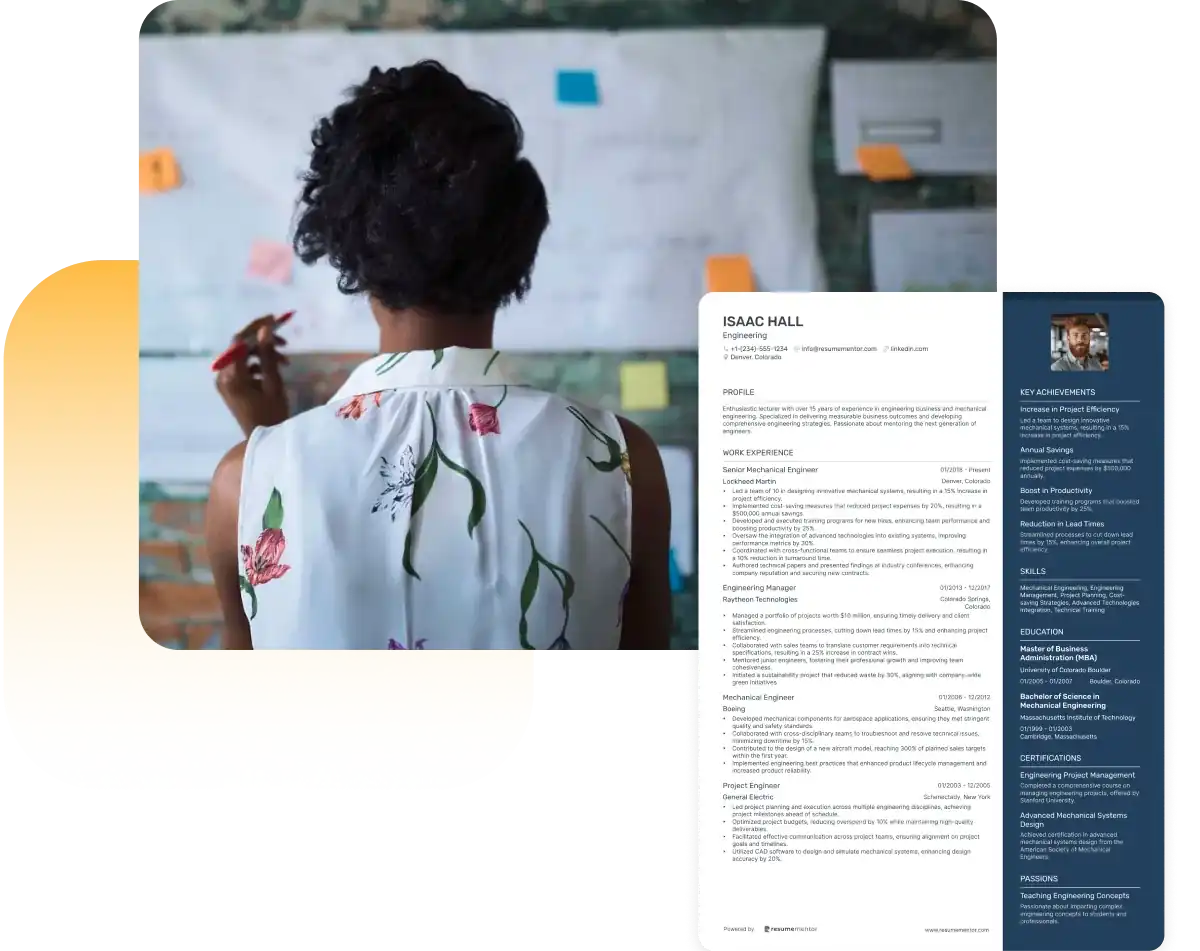
Continue Reading
Check more recommended readings to get the job of your dreams.
Resume
Resources
Tools
© 2025. All rights reserved.
Made with love by people who care.

